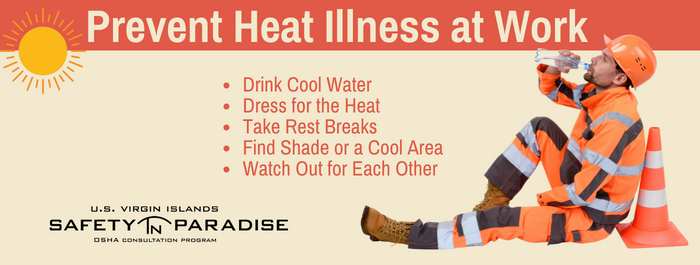 Safety in Paradise
Safety in Paradise
Information For...
Welcome to Safety in Paradise
What is Safety In Paradise
The program addresses immediate problems and offers professional advice and help in maintaining continued effective worker protection. Employers can find out about potential hazards at their worksites, improve their occupational safety and health management systems and even qualify for a one-year exemption from routine OSHA inspections.
HELP WANTED
We are currently recruiting for the following positions:
Register for upcoming workshops.
Information and Resources on the Coronavirus!
Helpful Hints & Tips
COVID-19 Resources
Vaccination & Testing
Emergency Temporary Standard
On November 12, 2021, the U.S. Court of Appeals for the Fifth Circuit granted a motion to stay OSHA's COVID-19 Vaccination and Testing Emergency Temporary Standard, published on November 5, 2021 (86 Fed. Reg. 61402) ("ETS"). The court ordered that OSHA "take no steps to implement or enforce" the ETS "until further court order." While OSHA remains confident in its authority to protect workers in emergencies, OSHA has suspended activities related to the implementation and enforcement of the ETS pending future developments in the litigation.
Click the link to read more about the Emergency Temporary Standard.
Additional Coronavirus Resources are also available here.
Recordkeeping and Recording Requirements
Did you know that March 2nd, is the deadline to electronically submit your OSHA Form 300A for the previous calendar year?
OSHA published a Final Rule to amend its recordkeeping regulation to remove the requirement to electronically submit to OSHA information from the OSHA Form 300 (Log of Work-Related Injuries and Illnesses) and OSHA Form 301 (Injury and Illness Incident Report) for establishments with 250 or more employees that are required to routinely keep injury and illness records. Covered establishments are only required to electronically submit information from the OSHA Form 300A (Summary of Work-Related Injuries and Illnesses). The requirement to keep and maintain OSHA Forms 300, 300A, and 301 for five years is not changed by this Final Rule.
Remember, not all establishments are covered by this requirement. Only a small fraction of establishments are required to electronically submit their Form 300A data to OSHA. Establishments that meet any of the following criteria DO NOT have to send their information to OSHA. Remember, these criteria apply at the establishment level, not to the firm as a whole.
- The establishment's peak employment during the previous calendar year was 19 or fewer, regardless of the establishment's industry.
- The establishment's industry is on this list, regardless of the size of the establishment.
- The establishment had peak employment between 20 and 249 employees during the previous calendar year AND the establishment's industry is not on this list.
For a full list of exempted industries, visit the Occupational Safety and Health Administration (OSHA) webpage.
Recordkeeping Requirements
Employers with more than 10 employees are required to keep a record of serious work-related injuries and illnesses. (Certain low-risk industries are exempted). Minor injuries requiring first aid only DO NOT need to be recorded.
- How does OSHA define a recordable injury or illness?
- How does OSHA define first aid?
This information helps employers, workers, and OSHA evaluate the safety of a workplace, understand industry hazards, and implement worker protections to reduce and eliminate hazards -- preventing future workplace injuries and illnesses.
Maintaining and Posting Records
Records must be maintained at the worksite for at least five (5) years. Each February through April, employers must post a summary of the injuries and illnesses recorded the previous year. Also, if requested, copies of the records must be provided to current and former employees, or their representatives.
- Get recordkeeping forms 300, 300A, 301, and additional instructions.
- Read the full OSHA Recordkeeping regulation (29 CFR 1904).
Updated Electronic Submission of Records
The Injury Tracking Application (ITA) is accessible from the ITA launch page, where you can provide the Agency your OSHA Form 300A information. The date by which certain employers are required to submit to OSHA the information from their completed Form 300A is March 2nd of the year after the calendar year covered by the form.
How does OSHA define a recordable injury or illness?
- Any work-related fatality.
- Any work-related injury or illness that results in loss of consciousness, days away from work, restricted work, or transfer to another job.
- Any work-related injury or illness requiring medical treatment beyond first aid.
- Any work-related diagnosed case of cancer, chronic irreversible diseases, fractured or cracked bones or teeth, and punctured eardrums.
- There are also special recording criteria for work-related cases involving: needlesticks and sharps injuries; medical removal; hearing loss; and tuberculosis.
How does OSHA define first aid?
- Using a non-prescription medication at nonprescription strength (for medications available in both prescription and non-prescription form, a recommendation by a physician or other licensed health care professional to use a non-prescription medication at prescription strength is considered medical treatment for recordkeeping purposes).
- Administering tetanus immunizations (other immunizations, such as Hepatitis B vaccine or rabies vaccine, are considered medical treatment); Cleaning, flushing or soaking wounds on the surface of the skin.
- Using wound coverings such as bandages, Band-Aids™, gauze pads, etc.; or using butterfly bandages or Steri-Strips™ (other wound closing devices such as sutures, staples, etc., are considered medical treatment).
- Using hot or cold therapy;
- Using any non-rigid means of support, such as elastic bandages, wraps, non-rigid back belts, etc. (devices with rigid stays or other systems designed to immobilize parts of the body are considered medical treatment for recordkeeping purposes);
- Using temporary immobilization devices while transporting an accident victim (e.g., splints, slings, neck collars, back boards, etc.). Drilling of a fingernail or toenail to relieve pressure, or draining fluid from a blister;
- Using eye patches;
- Removing foreign bodies from the eye using only irrigation or a cotton swab;
- Removing splinters or foreign material from areas other than the eye by irrigation, tweezers, cotton swabs or other simple means;
- Using finger guards;
- Using massages (physical therapy or chiropractic treatment are considered medical treatment for recordkeeping purposes); or
- Drinking fluids for relief of heat stress.
This information helps employers, workers, and OSHA evaluate the safety of a workplace, understand industry hazards, and implement worker protections to reduce and eliminate hazards, thereby preventing future workplace injuries and illnesses.
Maintaining and Posting Records
Records must be maintained at the worksite for at least five years. Each February through April, employers must post a summary of the injuries and illnesses recorded the previous year. Also, if requested, copies of the records must be provided to current and former employees, or their representatives.
Updated Electronic Submission of Records -- What does it require?
The new rule, which takes effect Jan. 1, 2017, requires certain employers to electronically submit injury and illness data that they are already required to record on their onsite OSHA Injury and Illness forms. Analysis of this data will enable OSHA to use its enforcement and compliance assistance resources more efficiently. Some of the data will also be posted to the OSHA website. OSHA believes that public disclosure will encourage employers to improve workplace safety and provide valuable information to workers, job seekers, customers, researchers and the general public. The amount of data submitted will vary depending on the size of company and type of industry.
How will electronic submission work?
OSHA has provided a secure website that offers three options for data submission. First, users are able to manually enter data into a webform. Second, users are able to upload a CSV file to process single or multiple establishments at the same time. Last, users of automated recordkeeping systems will have the ability to transmit data electronically via an API (application programming interface). The Injury Tracking Application (ITA) is accessible from the ITA launch page, where you are able to provide the Agency your 2017 OSHA Form 300A information. The date by which certain employers are required to submit to OSHA the information from their completed 2017 Form 300A is July 1, 2018.
- Learn more about OSHA's rule on submitting injury and illness records electronically.
- Download the Fact Sheet -- Final Rule to Improve Tracking of Workplace Injuries and Illnesses
Severe Injury Reporting
Employers must report any worker fatality within 8 hours and any amputation, loss of an eye, or hospitalization of a worker within 24 hours.
- Learn more about reporting online or by phone.
Ladder Safety
Every step matters: From step stools to extension ladders, make sure you're putting the right foot forward.
Every year over 100 people die in ladder-related accidents, and thousands suffer disabling injuries. Join the American Ladder Institute (ALI) and participate in the fourth annual National Ladder Safety Month February 23 - March 31. This important month was designed to raise awareness of ladder safety and to decrease the number of ladder-related injuries and fatalities.
What is National Ladder Safety Month?
National Ladder Safety Month is the only movement dedicated exclusively to the promotion of ladder safety, at home and at work. Help us bring awareness to the importance of the safe use of ladders through resources, training, and a national dialogue.
The goals of National Ladder Safety Month are to:
- Increase the frequency that ladder safety training modules are viewed on www.laddersafetytraining.org
- Lower the rankings of ladder-related safety citations on OSHA’s yearly “Top 10 Citations List”
- Decrease number of ladder-related injuries and fatalities
- Increase the number of in-person ladder training
- Increase the number of companies and individuals that inspect and properly dispose of old, damaged or obsolete ladders
Additional Resources
Article: Why Ladder Safety Training Should be Mandatory for Your Employees
Hurricane Preparedness and Response

Our Atlantic hurricane season lasts from June to November and peaks between August and October.
While hurricanes pose the greatest threat to life and property, tropical storms and depressions can also be devastating. The primary hazards from tropical cyclones are storm surge flooding, inland flooding from heavy rains, destructive winds, tornadoes and high surf and rip currents.
Employers can best protect themselves, their employees and their business from these hazards by conducting emergency planning for the hurricane season. Remember, few people can think clearly and logically in a crisis, so it is important to train and practice in advance.
Create a Plan
It is important to have an evacuation plan in place to ensure that workers can get to safety in case a tropical cyclone may affect the area.
A thorough evacuation plan should include:
- Conditions that will activate the plan
- Chain of command
- Emergency functions and who will perform them
- Specific evacuation procedures, including routes and exits
- Procedures for accounting for personnel, customers and visitors
- Equipment for personnel
Conduct Employee Training
In addition to having evacuation plans in place, provide training for your employees to ensure that all workers know what to do in case of an emergency. It is important to be familiar with the warning terms used for hurricanes, as well as your local community's emergency plans, warning signals, and shelters. Practice evacuation plans on a regular basis and remember to update plans and procedures based on lessons learned from exercises. Show employees what disaster supply kits are (if you have them) and let them know where they are located.
Additional information on hurricane preparedness may be found at OSHA’s Preparedness webpage - https://www.osha.gov/dts/weather/hurricane/preparedness.html - and the FEMA website - Ready.gov
UVICELL Safety In Paradise assists small and medium-sized employers by providing free OSHA On-Site Consultation Services. Request our FREE services at 340-693-1146 or via email at safetyinparadise@uvi.edu. To learn more about this free and confidential safety and health program visit: http://safety.uvi.edu/.
Also, Like US in Facebook - SafetyInParadise - so you can stay in touch with the latest news regarding occupational safety and health.
Reducing Workers' Exposure to Seasonal Flu Virus
Influenza (flu) is a contagious disease that can be serious. Every year, millions of people get sick, hundreds of thousands are hospitalized, and some even die from the flu. Employers can implement a combination of controls to protect their employees and reduce transmission of the seasonal flu in the workplace. Here are some basic precautions that can protect your employees during the flu season.
Encourage Workers to Get Vaccinated
Encourage employees to get the seasonal flu vaccine when it is available. An annual seasonal flu vaccine is the best way to reduce the risk of getting sick with the seasonal flu and spreading it to others. Every flu season is different, and influenza infection can affect people differently.
Encourage Sick Workers to Stay Home
The CDC recommends that workers who have a fever and respiratory symptoms stay at home until 24 hours after their fever ends (100 degrees Fahrenheit [37.8 degrees Celsius] or lower), without the use of medication. Not everyone who has the flu will have a fever. Other symptoms could include a runny nose, body aches, headache, tiredness, diarrhea, or vomiting. Develop flexible leave policies that encourage workers to stay home, without penalty, if they are sick.
Develop a Policy for Workers, and Clients Who Become Ill in the Workplace
Develop a policy on how to deal with workers and clients who may be ill with the flu and communicate it to your employees. Determine who will be responsible for assisting ill individuals in the workplace and make sure that at least one person can serve as the "go to" person if someone becomes sick in the workplace. Also, consider how to separate ill workers from others, or give them a surgical mask to wear, if possible and if they can tolerate until they can go home.
Promote Hand Hygiene and Cough Etiquette
Post signs that tell workers, visitors, and clients the steps for proper hand hygiene and cough etiquette. Workers, visitors, and clients should have easy access to supplies such as:
- "No touch" wastebaskets for used tissues;
- Soap and water;
- Alcohol-based hand rubs;
- Disposable towels;
- Cleaning and sanitation materials.
Lobbies, halls, and restrooms should have the above items and workers should know where they are.
Keep the Workplace Clean
Frequently clean all commonly touched work surfaces, work areas, and equipment (e.g., telephones, doorknobs, lunch areas, countertops, copiers, etc.). Use the cleaning agents that are usually used in these areas and follow the directions on the label. No additional disinfection beyond routine cleaning is recommended by the CDC. Provide disinfectants and disposable towels for workers to use to clean their workspaces and surfaces and to keep work areas clean.
Educate Workers About the Flu and Conditions that Place them at Higher Risk for Flu Complications
Train workers about how flu can be transmitted in the workplace and what precautions they can use to prevent transmission. Provide information about the following:
- signs, symptoms, and complications of the flu;
- policies and procedures for reporting flu symptoms, using sick leave, and returning to work;
- vaccination; and
- any required work practices.
CDC has identified groups that have a higher risk for complications from seasonal flu (e.g., elderly, pregnant women, small children, persons with asthma, etc.).
Inform workers that some people are at higher risk of complications from flu and suggest that they talk to their doctor about their own risk and what to do if they become ill.
Address Travel and Sickness While on Travel
Reconsider business travel to areas with high illness rates. The CDC recommends the following measures for workers who become ill while on travel:
- Advise workers who become ill while traveling or on temporary assignment to notify their supervisors.
- Workers who become ill while traveling and are at increased risk of flu complications and others concerned about their illness should promptly call a healthcare provider.
- Advise workers to check themselves for fever and any other signs of flu-like illness before starting travel and to notify their supervisors and stay home if they feel ill.
NEW Smart Phone App - OSHA/NIOSH Heat Safety Tool
Do you know there is a new tool right at your fingertips that can help keep workers safe from heat illness?

The Occupational Safety and Health Administration (OSHA) has collaborated with the National Institute for Occupational Safety and Health (NIOSH) to release the re-designed, co-branded OSHA-NIOSH Heat Safety Tool smartphone app.
The app is available for download on both iOS and Android devices:
iOS App Store | Android App Store
The app features the following:
- A visual indicator of the current heat index and associated risk levels specific to your current geographical location
- Precautionary recommendations specific to heat index-associated risk level
- An interactive, hourly forecast of heat index values, risk level, and recommendations for planning outdoor work activities in advance
- Editable location, temperature, and humidity controls for calculation of variable conditions;
- Signs and symptoms of heat-related illnesses including: heat stroke, heat exhaustion, rhabdomyolysis, heat cramps and heat rash
- First aid information for heat-related illnesses
Every year, dozens of workers die and thousands more become ill while working in extreme heat or humid conditions. Under OSHA law, employers are responsible for providing workplaces free of known safety hazards. This includes protecting workers from extreme heat. An employer with workers exposed to high temperatures should:
- Establish a complete heat illness prevention program
- Provide workers with water, rest and shade
- Allow new or returning workers to gradually increase workloads and take more frequent breaks as they acclimatize, or build a tolerance for working in the heat
- Plan for emergencies and train workers on prevention
- Monitor workers for signs of illness
For more information on this topic, about this app, and on how three simple words – Water, Rest, Shade — can help prevent heat-related illness and fatalities, visit OSHA's Occupational Exposure to Heat page at https://www.osha.gov/SLTC/heatstress/index.html.
UVICELL Safety In Paradise assists small and medium-sized employers by providing free OSHA On-Site Consultation Services. Request our FREE services at 340-693-1146, via email at safetyinparadise@uvi.edu or through our web page at http://safety.uvi.edu.
Also, Like US in Facebook (@SafetyInParadise) so you can stay in touch with the latest news regarding occupational safety and health.
Heat Illness Prevention
Overview: Working in Outdoor and Indoor Heat Environments
Millions of U.S. workers are exposed to heat in their workplaces. Although illness from exposure to heat is preventable, every year, thousands become sick from occupational heat exposure, and some cases are fatal. Most outdoor fatalities, 50% to 70%, occur in the first few days of working in warm or hot environments because the body needs to build a tolerance to the heat gradually over time. The process of building tolerance is called heat acclimatization. Lack of acclimatization represents a major risk factor for fatal outcomes.
Occupational risk factors for heat illness include heavy physical activity, warm or hot environmental conditions, lack of acclimatization, and wearing clothing that holds in body heat.
Hazardous heat exposure can occur indoors or outdoors and can occur during any season if the conditions are right, not only during heat waves. The following is a list of some industries where workers have suffered heat-related illnesses.
| Outdoors | Indoors |
|---|---|
| Agriculture | Bakeries, kitchens, and laundries (sources with indoor heat-generating appliances) |
| Construction – especially, road, roofing, and other outdoor work | Electrical utilities (particularly boiler rooms) |
| Construction – roofing work | Fire Service |
| Landscaping | Iron and steel mills and foundries |
| Mail and package delivery | Manufacturing with hot local heat sources, like furnaces (e.g., paper products or concrete) |
| Oil and gas well operations | Warehousing |
Heat-related illness is preventable, especially with management's commitment to providing the most effective controls. An effective heat-related illness prevention program is incorporated into a broader safety and health program and aligns with OSHA's Recommended Practices for Safety and Health Programs core elements.
Workers who have not spent time recently in warm or hot environments and/or being physically active will need time to build tolerance (acclimatize or, less frequently used, acclimate) to the heat. During their first few days in warm or hot environments, employers should encourage workers to:
- Consume adequate fluids (water and sports drinks)
- work shorter shifts,
- take frequent breaks, and
- quickly identify any heat illness symptoms.
Engineering controls such as air conditioning, with cooled air, and increased airflow, leading to increased evaporative cooling, can make the workplace safer. Other options for keeping body temperatures down in warm environments include making changes to workload and schedules. For example, empower supervisors and workers to slow down physical activity like reducing manual handling speeds or scheduling work for the morning or shorter shifts with frequent rest breaks in the shade or at least away from heat sources. Supervisors can encourage workers in warm environments to drink hydrating fluids. At a minimum, all supervisors and workers should receive training about heat-related symptoms and first aid.
Heat-related illnesses can have a substantial cost to workers and employers. Heat stress can cause fine motor performance (like rebar tying or keyboarding) to deteriorate even in acclimatized individuals. Heat illness can contribute to decreased performance, lost productivity due to illness and hospitalization, and possibly death. OSHA encourages water, rest, and shade as prevention as well as treatment for heat-related illnesses.
For assistance in developing a safety and health program or for more information on heat-related illnesses, contact the UVI CELL Safety In Paradise office at (340) 692-4051/(340) 692-4082 or email safetyinparadise@uvi.edu.
Remember, our consultation services are free and confidential for private-sector businesses and non-profits.
Occupational Noise Exposure
Overview
The Center for Disease Control (CDC) estimates that 22 million workers are exposed to potentially damaging noise at work each year. Whether you work at a sports venue, on a tarmac, or operate a jackhammer—hearing loss is preventable.
Know Your Workplace Noise Levels!
If you need to raise your voice to speak to someone 3 feet away, noise levels might be over 85 decibels. Several sound-measuring instruments are available to measure the noise levels in a workspace. These include sound level meters, noise dosimeters, and octave band analyzers.
Noise may be a problem in your workplace if you:
- Hear ringing or humming in your ears when you leave work.
- Have to shout to be heard by a coworker an arm's length away.
- Experience temporary hearing loss when leaving work.
The National Institute for Occupational Safety and Health (NIOSH) Sound Level Meter App is one tool available to the public to download on mobile iOS devices that measure sound levels in the workplace and provides noise exposure parameters to help reduce occupational noise-induced hearing loss.
Standards
OSHA requires employers to implement a hearing conservation program when noise exposure is at or above 85 decibels averaged over 8 working hours, or an 8-hour time-weighted average (TWA). Hearing conservation programs strive to prevent initial occupational hearing loss, preserve and protect remaining hearing, and equip workers with the knowledge and hearing protection devices necessary to safeguard themselves.
Health Effects
Exposure to loud noise kills the nerve endings in our inner ear. More exposure will result in more dead nerve endings. The result is permanent hearing loss that cannot be corrected through surgery or with medicine. Noise-induced hearing loss limits your ability to hear high-frequency sounds and understand speech, which seriously impairs your ability to communicate. Hearing aids may help, but they do not restore your hearing to normal.
Exposure & Controls
Ways to control worker exposure to excessive noise and prevent hearing loss include using quieter machines, isolating the noise source, limiting worker exposure, or using effective protective equipment.
For assistance in developing a health and safety plan for your workplace, contact us at (340) 693-1146 or send an email to safetyinparadise@uvi.edu.




